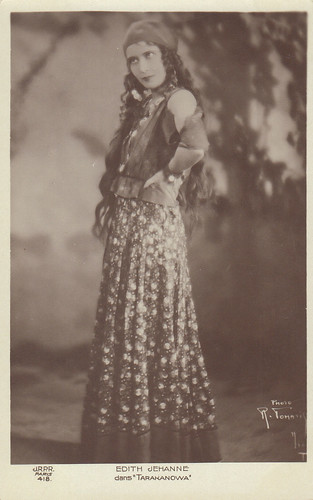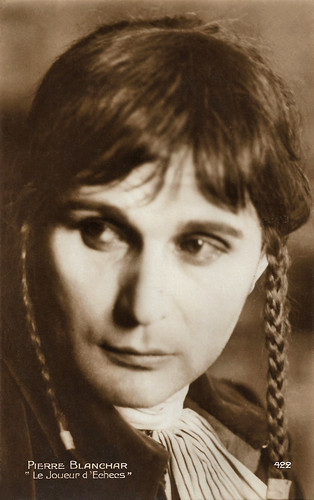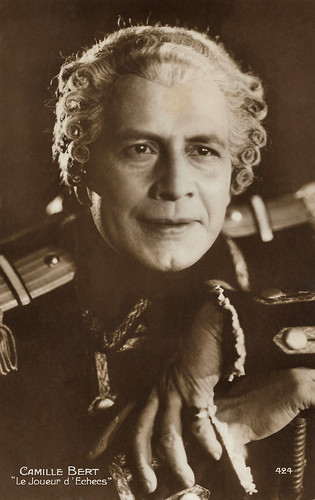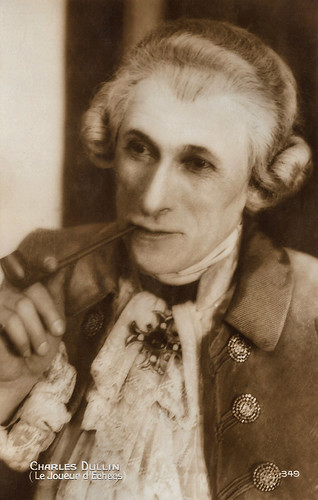French actress Edith Jéhanne (1899-1949) is known for two classic silent films, Le Joueur d'échecs/The Chess player (Raymond Bernard, 1927) and Die Liebe der Jeanne Ney/The Love of Jeanne Ney (Georg Wilhelm Pabst, 1927). After that, she would make only three more films. What finished her promising film career?

French postcard by Cinémagazine-Edition, no. 421. Photo: publicity still for Le joueur d'échecs/The Chess Player (1927).
Edith Jéhanne was born Édith Jeanne Cosson in 1899 in Châteauroux, France. She was the daughter of Jean Baptiste Léonce Louis Cosson, a locksmith, and Thérèze Tartière, a seamstress. Edith's sister, Elodie Cosson (1901-1954) appeared in a few French films in the 1920s, under the pseudonym of Sylvia Grey. The two sisters appeared together on the cover of the magazine Mon Ciné on 13 September 1923. They also had a brother, painter Hélier Cosson (1897-1976).
Edith was discovered by Raymond Bernard when she came to visit the set of Le Secret de Rosette Lambert/The Secret of Rosette Lambert (Raymond Bernard, 1920). Jéhanne debuted in his sentimental comedy Triplepatte/Toddles (Raymond Bernard, 1922) based on a play by Bernard's father, Tristan Bernard. Next, she performed in the adventure serial Rouletabille chez les bohemiens/Rouletabille Among the Bohemians (Henri Fescourt, 1923), opposite Gabriel de Gravone, Romuald Joubé and Joë Hamman. She chose her two first names, spelt differently, as her stage names.
The following year she had a small part in Bernard's historical drama Le miracle des loups/The Miracle of the Wolves (Raymond Bernard, 1924), an epic film about the struggle between Louis XI (Charles Dullin) and Charles le Téméraire (Jean-Emile Vanni-Marcoux). The film turned its eye to a moment of French glory, the late 15th century when a sense of national unity had yet to be forged. In France, it was the most popular film of 1924.
1927 was her peak year. Jéhanne got the lead in two major films. First in the Ufa production Die Liebe der Jeanne Ney/The Love Of Jeanne Ney (Georg Wilhelm Pabst, 1927), based on a story by Ilya Ehrenburg. Jéhanne plays Jeanne Ney, a woman tormented by the political upheavals of the period following the First World War. When the Red Army occupies Crimea, Jeanne's father, a French journalist, is killed.
Jeanne's lover, the Bolshevik Andreas (Uno Henning), sends Jeanne to her family in Paris but he is preceded by the counterrevolutionary Khalibiev (Fritz Rasp), who murders Jeanne's uncle. Andreas is accused of the murder and Khalibiev proposes to marry Jeanne's blind cousin (Brigitte Helm). Director Pabst mixed here successfully a straightforward American film style with echoes of the Soviet montage style and German expressionism.

German postcard by Ross Verlag, no. 4300/1, 1929-1930. Photo: D.L.S. / Rosenfeld-Film G.m.b.H.

Dutch postcard for the Al Film Co., Batavia-Centrum (former Dutch East Indies, now Indonesia), no. T. 93. Photo: R. Tomarig, Nice. Publicity still for Tarakanova (Raymond Bernard, 1930). This picture was also used for posters and magazine covers.
Then, Edith Jéhanne and Pierre Blanchar played the lead in Le joueur d'échecs/The Chess Player (Raymond Bernard, 1927), about 19th century Poland striving for independence. Polish freedom fighter Boleslas loves Sophie, and they are both active in the independence movement. She becomes attracted to Oblonoff, a young officer in charge of the Russian forces in Poland. When Boleslas is wounded during an insurrection at Vilmo, Sophie stays at his side. He is hidden in a chess-player mannequin that ends up at the court of the Russian Czarina Catherine II. He plays against her...
The film was a grand spectacle, using 35 decors including an enormous set for the Winter Palace. Hal Erickson described at AllMovie the highlight of the film: "The film's dramatic highlight was one of the most astonishing sequences in all of French cinema: On the verge of madness because her beloved Polish army is being mercilessly slaughtered by the Russians, the heroine sits down at her piano and begins playing maniacally - whereupon she hallucinates that the Poles have won the battle and are marching homeward in triumph."
However, after these major works, Edith Jéhanne only made three more films. In two she had the female lead: the psychological drama Le perroquet vert/The Green Parrot (Jean Milva, 1928) with Max Maxudian, and the late silent production Tarakanova (Raymond Bernard, 1930) with Olaf Fjord and Rudolf Klein-Rogge.
In this film, she played Princess Tarakanova, an impostor who claims to be the heir to the throne in Eighteenth-Century Russia. When the Czarina (Paule Andral) sends her best aid to capture the girl, he falls in love with her. It was Bernard's last silent film, shot in 1929, but held back to add a soundtrack in 1930. Bernard considered it his best film, but no copy of the film ever showed up.
After that, Jéhanne only had a minor part in the early sound film Quand nous étions deux/When We Were Two (Léonce Perret, 1929), starring Alice Roberts and André Roanne. And then her promising film career stopped. Was it because of her 1927 marriage to Henri Jules Louis Bouyer, a dental school director? Was the advent of sound film the reason? Edith Jéhanne died in 1949 in Saint-Briac-sur-Mer. She was only 50.

French postcard by J.R.P.R. Paris, no. 418. Photo: Robert Tomatis. Edith Jéhanne in Tarakanova (Raymond Bernard, 1930). Collection: Marlene Pilaete.
Sources: Hal Erickson (AllMovie - Page now defunct), Les Gens du Cinema (French), Wikipedia (English and French), Filmportal and IMDb.
This post was last updated on 7 April 2025. With thanks to Marlène Pilaete.

French postcard by Cinémagazine-Edition, no. 421. Photo: publicity still for Le joueur d'échecs/The Chess Player (1927).
Tormented by the political upheavals
Edith Jéhanne was born Édith Jeanne Cosson in 1899 in Châteauroux, France. She was the daughter of Jean Baptiste Léonce Louis Cosson, a locksmith, and Thérèze Tartière, a seamstress. Edith's sister, Elodie Cosson (1901-1954) appeared in a few French films in the 1920s, under the pseudonym of Sylvia Grey. The two sisters appeared together on the cover of the magazine Mon Ciné on 13 September 1923. They also had a brother, painter Hélier Cosson (1897-1976).
Edith was discovered by Raymond Bernard when she came to visit the set of Le Secret de Rosette Lambert/The Secret of Rosette Lambert (Raymond Bernard, 1920). Jéhanne debuted in his sentimental comedy Triplepatte/Toddles (Raymond Bernard, 1922) based on a play by Bernard's father, Tristan Bernard. Next, she performed in the adventure serial Rouletabille chez les bohemiens/Rouletabille Among the Bohemians (Henri Fescourt, 1923), opposite Gabriel de Gravone, Romuald Joubé and Joë Hamman. She chose her two first names, spelt differently, as her stage names.
The following year she had a small part in Bernard's historical drama Le miracle des loups/The Miracle of the Wolves (Raymond Bernard, 1924), an epic film about the struggle between Louis XI (Charles Dullin) and Charles le Téméraire (Jean-Emile Vanni-Marcoux). The film turned its eye to a moment of French glory, the late 15th century when a sense of national unity had yet to be forged. In France, it was the most popular film of 1924.
1927 was her peak year. Jéhanne got the lead in two major films. First in the Ufa production Die Liebe der Jeanne Ney/The Love Of Jeanne Ney (Georg Wilhelm Pabst, 1927), based on a story by Ilya Ehrenburg. Jéhanne plays Jeanne Ney, a woman tormented by the political upheavals of the period following the First World War. When the Red Army occupies Crimea, Jeanne's father, a French journalist, is killed.
Jeanne's lover, the Bolshevik Andreas (Uno Henning), sends Jeanne to her family in Paris but he is preceded by the counterrevolutionary Khalibiev (Fritz Rasp), who murders Jeanne's uncle. Andreas is accused of the murder and Khalibiev proposes to marry Jeanne's blind cousin (Brigitte Helm). Director Pabst mixed here successfully a straightforward American film style with echoes of the Soviet montage style and German expressionism.

German postcard by Ross Verlag, no. 4300/1, 1929-1930. Photo: D.L.S. / Rosenfeld-Film G.m.b.H.

Dutch postcard for the Al Film Co., Batavia-Centrum (former Dutch East Indies, now Indonesia), no. T. 93. Photo: R. Tomarig, Nice. Publicity still for Tarakanova (Raymond Bernard, 1930). This picture was also used for posters and magazine covers.
Grand spectacle
Then, Edith Jéhanne and Pierre Blanchar played the lead in Le joueur d'échecs/The Chess Player (Raymond Bernard, 1927), about 19th century Poland striving for independence. Polish freedom fighter Boleslas loves Sophie, and they are both active in the independence movement. She becomes attracted to Oblonoff, a young officer in charge of the Russian forces in Poland. When Boleslas is wounded during an insurrection at Vilmo, Sophie stays at his side. He is hidden in a chess-player mannequin that ends up at the court of the Russian Czarina Catherine II. He plays against her...
The film was a grand spectacle, using 35 decors including an enormous set for the Winter Palace. Hal Erickson described at AllMovie the highlight of the film: "The film's dramatic highlight was one of the most astonishing sequences in all of French cinema: On the verge of madness because her beloved Polish army is being mercilessly slaughtered by the Russians, the heroine sits down at her piano and begins playing maniacally - whereupon she hallucinates that the Poles have won the battle and are marching homeward in triumph."
However, after these major works, Edith Jéhanne only made three more films. In two she had the female lead: the psychological drama Le perroquet vert/The Green Parrot (Jean Milva, 1928) with Max Maxudian, and the late silent production Tarakanova (Raymond Bernard, 1930) with Olaf Fjord and Rudolf Klein-Rogge.
In this film, she played Princess Tarakanova, an impostor who claims to be the heir to the throne in Eighteenth-Century Russia. When the Czarina (Paule Andral) sends her best aid to capture the girl, he falls in love with her. It was Bernard's last silent film, shot in 1929, but held back to add a soundtrack in 1930. Bernard considered it his best film, but no copy of the film ever showed up.
After that, Jéhanne only had a minor part in the early sound film Quand nous étions deux/When We Were Two (Léonce Perret, 1929), starring Alice Roberts and André Roanne. And then her promising film career stopped. Was it because of her 1927 marriage to Henri Jules Louis Bouyer, a dental school director? Was the advent of sound film the reason? Edith Jéhanne died in 1949 in Saint-Briac-sur-Mer. She was only 50.

French postcard by J.R.P.R. Paris, no. 418. Photo: Robert Tomatis. Edith Jéhanne in Tarakanova (Raymond Bernard, 1930). Collection: Marlene Pilaete.
Sources: Hal Erickson (AllMovie - Page now defunct), Les Gens du Cinema (French), Wikipedia (English and French), Filmportal and IMDb.
This post was last updated on 7 April 2025. With thanks to Marlène Pilaete.


